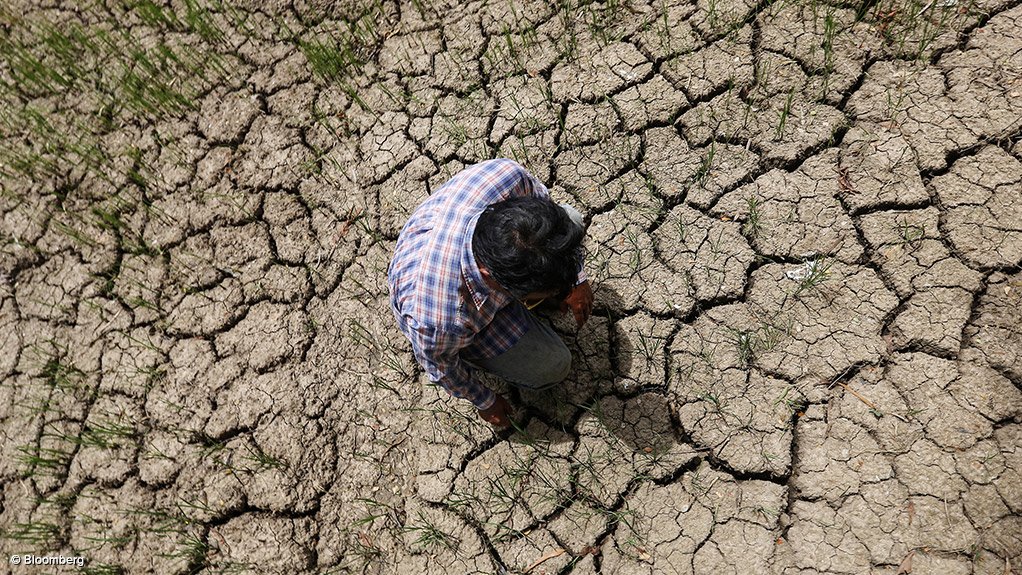Budget sets aside R1.1bn for drought relief
As South Africa’s water woes worsen on the back of a protracted drought, Finance Minister Pravin Gordhan on Wednesday announced relief initiatives totalling R1.1-billion over the medium term.
The reprioritised funds aimed to alleviate the pressure of a severe drought on the farming sector and water-stressed communities, with this year’s medium-term expenditure framework allocating funds towards interventions such as drilling boreholes, distributing animal feed, moving cattle herds and transporting potable water to drought-affected areas.
Disaster relief measures and support for livestock farmers were also accounted for in the 2016 Budget, tabled by Gordhan in Parliament on Wednesday.
This year, the Department of Water and Sanitation (DWS) would spend R502-million on the procurement of water tankers, the delivery of water to hard-hit regions, the protection of springs and the refurbishment of boreholes as drought conditions continued, leading to rising prices and threats to water supply in many areas.
Last year, several drought-response measures were implemented, such as drilling and rehabilitating boreholes, water conservation and demand management projects, augmenting water sources, providing livestock feed and alternative grazing and monitoring food prices to develop interventions to maintain food security.
Owing to the “considerable uncertainty” about the amount of crop each hectare would yield given the late planting as a result of the drought, it was expected that about five-million tons of maize would be imported this year at a cost of between R15-billion and R19-billion – or 0.35% to 0.45% of gross domestic product – a surge on the R2-billion posted in the prior year.
The departments of Rural Development and Land Reform and Agriculture, Forestry and Fisheries had provided R187-million and R450-million respectively for the provision of grazing land for animals in drought-stricken areas and support for the country’s drought-relief efforts for 2016/17.
Provincial agriculture departments had offered support to farmers affected by the drought, with R159-million set aside under the comprehensive agricultural support programme grant to help mitigate the effects of the drought and ensure production continues, assisted by a further R54-million allocated from the municipal disaster and the provincial disaster grants.
Resources would be made available to support additional interventions as they were identified, while changes to the provincial and municipal disaster relief grants were also proposed to further support these efforts.
A Department of Cooperative Governance and Traditional Affairs-led interdepartmental task team had been established to oversee government’s response to the drought; however, the National Treasury called on South Africans to consider how the economy and households could adapt to the challenges of a water-stressed country over the long term.
Meanwhile, work would continue on several water and sanitation initiatives currently under way, with spending on water resources and bulk infrastructure over the medium term expected to increase at an average rate of 16.1% a year to R36.4-billion.
Around R15-billion had been allocated to the regional bulk infrastructure grant programme over the next three years to upgrade and refurbish ageing water infrastructure and build bulk water and sanitation infrastructure, including raising the Clanwilliam dam wall and building pipelines for the Olifants River Water Resources Development Project (ORWRDP).
Phase 2C of the ORWRDP and the Steelpoort pumping station had been initiated, with phases 2B and 2D of the ORWRDP to start over the medium term, for completion in 2020.
The water services infrastructure grant had been allocated R12-billion to improve water supply in poor communities, with R5.5-billion set aside for the Water Trading Entity for capital projects, including acid mine drainage mitigation.
Water boards were also preparing to increase their spending in the period ahead by R6-billion, mainly for Rand Water’s bulk water infrastructure in the Bushbuckridge area, Magalies Water’s Pilanesberg water project and Umgeni Water’s Kwazulu-Natal bulk water-supply master plan.
The DWS would also provide funding and institutional support to municipalities and implementing agents to complete 234 small water and wastewater services projects.
Comments
Announcements
What's On
Subscribe to improve your user experience...
Option 1 (equivalent of R125 a month):
Receive a weekly copy of Creamer Media's Engineering News & Mining Weekly magazine
(print copy for those in South Africa and e-magazine for those outside of South Africa)
Receive daily email newsletters
Access to full search results
Access archive of magazine back copies
Access to Projects in Progress
Access to ONE Research Report of your choice in PDF format
Option 2 (equivalent of R375 a month):
All benefits from Option 1
PLUS
Access to Creamer Media's Research Channel Africa for ALL Research Reports, in PDF format, on various industrial and mining sectors
including Electricity; Water; Energy Transition; Hydrogen; Roads, Rail and Ports; Coal; Gold; Platinum; Battery Metals; etc.
Already a subscriber?
Forgotten your password?
Receive weekly copy of Creamer Media's Engineering News & Mining Weekly magazine (print copy for those in South Africa and e-magazine for those outside of South Africa)
➕
Recieve daily email newsletters
➕
Access to full search results
➕
Access archive of magazine back copies
➕
Access to Projects in Progress
➕
Access to ONE Research Report of your choice in PDF format
RESEARCH CHANNEL AFRICA
R4500 (equivalent of R375 a month)
SUBSCRIBEAll benefits from Option 1
➕
Access to Creamer Media's Research Channel Africa for ALL Research Reports on various industrial and mining sectors, in PDF format, including on:
Electricity
➕
Water
➕
Energy Transition
➕
Hydrogen
➕
Roads, Rail and Ports
➕
Coal
➕
Gold
➕
Platinum
➕
Battery Metals
➕
etc.
Receive all benefits from Option 1 or Option 2 delivered to numerous people at your company
➕
Multiple User names and Passwords for simultaneous log-ins
➕
Intranet integration access to all in your organisation




















